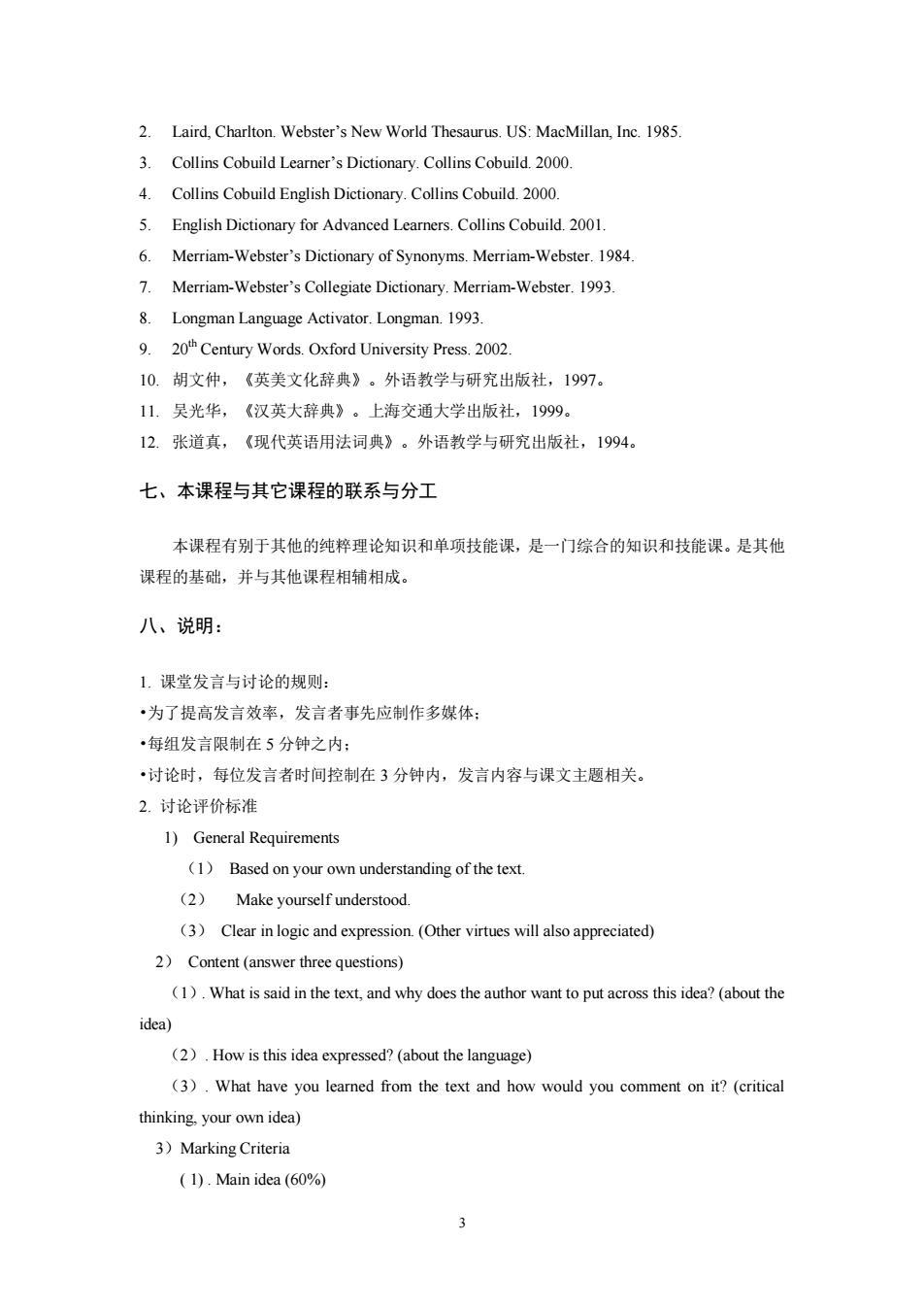正在加载图片...

2.Laird,Charlton.Webster's New World Thesaurus.US:MacMillan,Inc.1985 3.Collins Cobuild Learner's Dictionary.Collins Cobuild.2000. 4.Collins Cobuild English Dictionary.Collins Cobuild.000. 5.English Dictionary for Advanced Learners.Collins Cobuild.2001 6.Merriam-Webster's Dictionary of Synonyms.Merriam-Webster.1984. 7.Merriam-Webster's Collegiate Dictionary.Merriam-Webster.1993. 8.Longman Language Activator.Longman.1993 9.hCentury Words.Oxford University Press.2002 10.胡文仲,《英美文化辞典》。外语教学与研究出版社,1997。 11.吴光华,《汉英大辞典》。上海交通大学出版社,1999。 12.张道真,《现代英语用法词典》。外语教学与研究出版社,1994。 七、本课程与其它课程的联系与分工 本课程有别于其他的纯粹理论知识和单项技能课,是一门综合的知识和技能课。是其他 课程的基础,并与其他课程相辅相成。 八、说明: 1.课堂发言与讨论的规则: ·为了提高发言效率,发言者事先应制作多媒体: ·每组发言限制在5分钟之内: ·讨论时,每位发言者时间控制在3分钟内,发言内容与课文主题相关。 2.讨论评价标准 1)General Requirements (1)Based on your own understanding of the text (2)Make yourself understood. (3)Clear in logic and expression.(Other virtues will also appreciated) 2)Content(answer three questions) (1).What is said in the text,and why does the author want to put across this idea?(about the idea) (2).How is this idea expressed?(about the language) (3).What have you learned from the text and how would you comment on it?(critical thinking.your own idea) 3)MarkingCriteria (1).Main idea(60%)3 2. Laird, Charlton. Webster’s New World Thesaurus. US: MacMillan, Inc. 1985. 3. Collins Cobuild Learner’s Dictionary. Collins Cobuild. 2000. 4. Collins Cobuild English Dictionary. Collins Cobuild. 2000. 5. English Dictionary for Advanced Learners. Collins Cobuild. 2001. 6. Merriam-Webster’s Dictionary of Synonyms. Merriam-Webster. 1984. 7. Merriam-Webster’s Collegiate Dictionary. Merriam-Webster. 1993. 8. Longman Language Activator. Longman. 1993. 9. 20th Century Words. Oxford University Press. 2002. 10. 胡文仲,《英美文化辞典》。外语教学与研究出版社,1997。 11. 吴光华,《汉英大辞典》。上海交通大学出版社,1999。 12. 张道真,《现代英语用法词典》。外语教学与研究出版社,1994。 七、本课程与其它课程的联系与分工 本课程有别于其他的纯粹理论知识和单项技能课,是一门综合的知识和技能课。是其他 课程的基础,并与其他课程相辅相成。 八、说明: 1. 课堂发言与讨论的规则: •为了提高发言效率,发言者事先应制作多媒体; •每组发言限制在 5 分钟之内; •讨论时,每位发言者时间控制在 3 分钟内,发言内容与课文主题相关。 2. 讨论评价标准 1) General Requirements (1) Based on your own understanding of the text. (2) Make yourself understood. (3) Clear in logic and expression. (Other virtues will also appreciated) 2) Content (answer three questions) (1). What is said in the text, and why does the author want to put across this idea? (about the idea) (2). How is this idea expressed? (about the language) (3). What have you learned from the text and how would you comment on it? (critical thinking, your own idea) 3)Marking Criteria ( 1) . Main idea (60%)